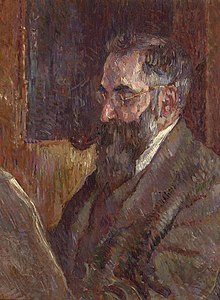You can help expand this article with text translated from the corresponding article in German. (February 2023) Click [show] for important translation instructions.
|
Lucien Pissarro (20 February 1863 – 10 July 1944) was a French landscape painter, printmaker, wood engraver, designer, and printer of fine books. His landscape paintings employ techniques of Impressionism and Neo-Impressionism, but he also exhibited with Les XX. Apart from his landscapes, he painted a few still lifes and family portraits. Until 1890 he worked in France, but thereafter was based in Great Britain. He was the oldest son of the French Impressionist painter Camille Pissarro and his wife Julie (née Vellay).[1]
Lucien Pissarro | |
|---|---|
 Lucien Pissarro Reading, by J.B. Manson c.1913 | |
| Born | 20 February 1863 |
| Died | 10 July 1944 (aged 81) |
| Nationality | French, British citizen |
| Known for | Landscape painting, printmaking, wood engraving |
| Movement | Impressionism Neo-Impressionism |
| Spouse | |

Biography
editPissarro was born on 20 February 1863 in Paris, French Third Republic.[1] He was the oldest of seven children; the son of French Impressionist painter Camille Pissarro and his wife Julie (née Vellay).[1] He studied with his father and—like his siblings Georges and Félix—he spent his formative years surrounded by his father's fellow artists, such as Claude Monet and Pierre-Auguste Renoir, who frequented the Pissarro home. He was influenced by Georges Seurat and Paul Signac.
He first visited Great Britain in 1870–71, during the Franco-Prussian War. He returned in 1883–84, and in 1890 settled permanently in London.[1] In 1886, he exhibited at the last of the Impressionist exhibitions.[1] From 1886 to 1894, he exhibited with the Salon des Independents. On 10 August 1892, he married Esther Levi Bensusan in Richmond.[1] While renting a cottage at Epping, Essex on 8 October 1893, their daughter and only child, Orovida Camille Pissarro, was born. Orovida also became an artist.[1] He met Charles Ricketts and Charles Shannon, and contributed woodcuts to their Dial. In 1894, he founded the Eragny Press[2] and with his wife and illustrated and printed books until the press was closed in 1914. In 1897, the family moved to 62 Bath Road in Stamford Brook, Chiswick.[1] In 1903, he designed the typeface Brook Type.[3]
Pissarro associated with Walter Sickert in Fitzroy Street, and in 1906 became a member of the New English Art Club. From 1913 to 1919, he painted landscapes of Dorset, Westmorland, Devon, Essex, Surrey and Sussex.
In 1916, Pissarro became a British citizen. While in Britain he was one of the founders of the Camden Town Group of artists. In 1919,[4] he formed the Monarro Group with J.B. Manson as the London Secretary and Théo van Rysselberghe as the Paris secretary, aiming to show artists inspired by Impressionist painters, Claude Monet and Camille Pissarro. The group ceased three years later.[5]
From 1922 to 1937, he painted regularly in the south of France, interspersed with painting expeditions to Derbyshire, south Wales and Essex. From 1934 to 1944, he exhibited at the Royal Academy in London. He died on 10 July 1944, in Hewood, Dorset.
References
edit- ^ a b c d e f g h Lucien Pissarro 1863–1944. Tate. February 2011. ISBN 9781849763851. Retrieved 13 June 2013.
- ^ Guide to the Eragny Press records, 1920–1923 at The Bancroft Library
- ^ Jaspert, W. Pincus, W. Turner Berry and A.F. Johnson. The Encyclopedia of Type Faces. Blandford Press Lts.: 1953, 1983, ISBN 0-7137-1347-X, p. 31
- ^ Buckman, David (2006), Dictionary of Artists in Britain since 1945 Volume 2, p. 1056. Art Dictionaries Ltd, Bristol. ISBN 0-9532609-5-X
- ^ "James Bolivar Manson", Tate collection online, material from Mary Chamot, Dennis Farr and Martin Butlin, The Modern British Paintings, Drawings and Sculpture, London 1964, II. Retrieved 18 December 2007.
Further reading
edit- Arts Council, Lucien Pissarro 1863–1944 a centenary exhibition (1963)
- Bensusan-Butt, J. Recollections of Lucien Pissarro in his seventies (1977)
- Bidwell, J. MacGregor, M. (eds), Pastorale, wood engravings by Lucien Pissarro, (2011. Whittington Press)
- Canterbury City Council Museums, Lucien Pissarro his influence on English art 1890–1914 (1986)
- Fine Art Society, Drawings, watercolours, oil paintings, woodcuts and etchings by Lucien Pissarro 1863–1944 (2003)
- Genz, M. D. A History of the Eragny Press 1894–1914 (2004)
- Jenkins, D. F. and Bonett, H. Lucien Pissarro 1863–1944, February 2011, in Helena Bonett, Ysanne Holt, Jennifer Mundy (eds.), The Camden Town Group in Context, Tate (2012)
- Meadmore, W. S. Lucien Pissarro un coeur simple (1962)
- Pissarro, C. Camille Pissarro, Lettres à son fils Lucien, ed. J. Rewald (Editions Albin Michel, Paris 1950) [English translation: 'Camille Pissarro, Letters to his son Lucien']
- Pissarro, C. Correspondance de Camille Pissarro, ed. J. Bailly-Herzberg (5 vols., Presses Universitaires de France, Paris, 1980 & Editions du Valhermeil, Paris, 1986–1991) ISBN 2-13-036694-5 – ISBN 2-905684-05-4 – ISBN 2-905684-09-7 – ISBN 2-905684-17-8 – ISBN 2-905684-35-6
- Pissarro, L. The letters of Lucien to Camille Pissarro 1883–1903, ed. A. Thorold (Cambridge University Press, Cambridge, New York & Oakleigh, 1993) ISBN 0-521-39034-6
- Reed, N. Pissarro in West London (Lilburne Press 1997) ISBN 1 901167 02 X
- Reed, N. Pissarro in Essex (Lilburne Press 1992) ISBN 0 9515258 4 0
- Thorold, A. A Catalogue of the oil paintings of Lucien Pissarro (1983)
- Urbanelli, L. The wood engravings of Lucien Pissarro ... (1994)
- Whiteley, J. (ed). Ashmolean Museum, Lucien Pissarro in England: the Eragny Press 1895–1914, (2011)
External links
edit- 99 artworks by or after Lucien Pissarro at the Art UK site
- An artwork by Lucien Pissarro at the Ben Uri site
- Works by Lucien Pissarro at Project Gutenberg
- Works by or about Lucien Pissarro at the Internet Archive
- Works
- Signac, 1863–1935, a fully digitized exhibition catalog from The Metropolitan Museum of Art Libraries, which contains material on Pissarro (see index)